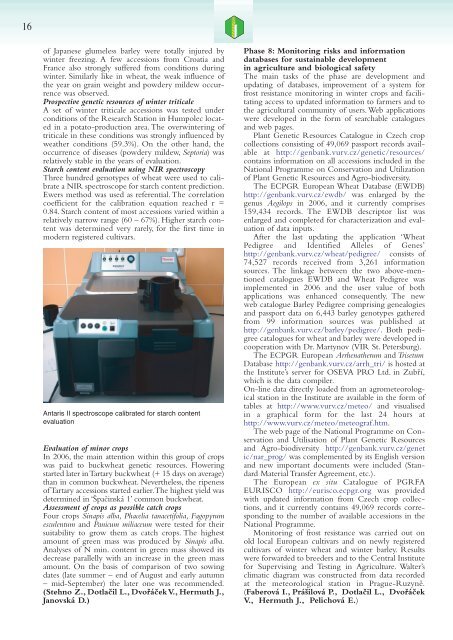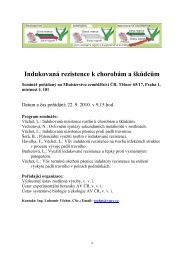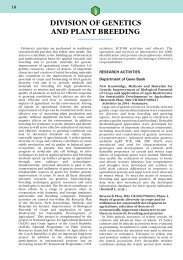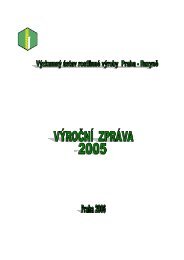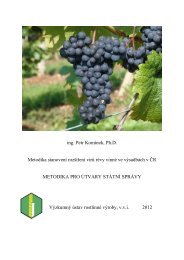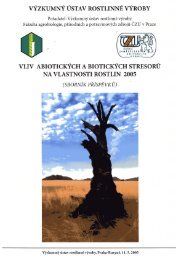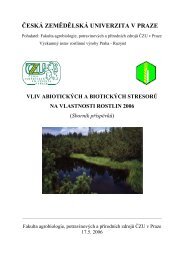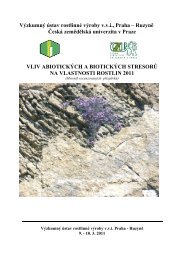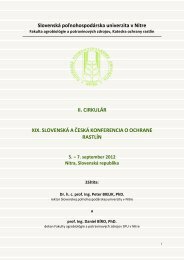00 ZLOM VURV 06 v roce 07
00 ZLOM VURV 06 v roce 07
00 ZLOM VURV 06 v roce 07
You also want an ePaper? Increase the reach of your titles
YUMPU automatically turns print PDFs into web optimized ePapers that Google loves.
16<br />
of Japanese glumeless barley were totally injured by<br />
winter freezing. A few accessions from Croatia and<br />
France also strongly suffered from conditions during<br />
winter. Similarly like in wheat, the weak influence of<br />
the year on grain weight and powdery mildew occurrence<br />
was observed.<br />
Prospective genetic resources of winter triticale<br />
A set of winter triticale accessions was tested under<br />
conditions of the Research Station in Humpolec located<br />
in a potato-production area. The overwintering of<br />
triticale in these conditions was strongly influenced by<br />
weather conditions (59.3%). On the other hand, the<br />
occurrence of diseases (powdery mildew, Septoria) was<br />
relatively stable in the years of evaluation.<br />
Starch content evaluation using NIR spectroscopy<br />
Three hundred genotypes of wheat were used to calibrate<br />
a NIR spectroscope for starch content prediction.<br />
Ewers method was used as referential.The correlation<br />
coefficient for the calibration equation reached r =<br />
0.84. Starch content of most accessions varied within a<br />
relatively narrow range (60 – 67%). Higher starch content<br />
was determined very rarely, for the first time in<br />
modern registered cultivars.<br />
Antaris II spectroscope calibrated for starch content<br />
evaluation<br />
Evaluation of minor crops<br />
In 2<strong>00</strong>6, the main attention within this group of crops<br />
was paid to buckwheat genetic resources. Flowering<br />
started later in Tartary buckwheat (+ 15 days on average)<br />
than in common buckwheat. Nevertheless, the ripeness<br />
of Tartary accessions started earlier.The highest yield was<br />
determined in ‘·paãinská 1’ common buckwheat.<br />
Assessment of crops as possible catch crops<br />
Four crops Sinapis alba, Phacelia tanacetifolia, Fagopyrum<br />
esculentum and Panicum miliaceum were tested for their<br />
suitability to grow them as catch crops. The highest<br />
amount of green mass was produced by Sinapis alba.<br />
Analyses of N min. content in green mass showed its<br />
decrease parallelly with an increase in the green mass<br />
amount. On the basis of comparison of two sowing<br />
dates (late summer – end of August and early autumn<br />
– mid-September) the later one was recommended.<br />
(Stehno Z., Dotlaãil L., Dvofiáãek V., Hermuth J.,<br />
Janovská D.)<br />
Phase 8: Monitoring risks and information<br />
databases for sustainable development<br />
in agriculture and biological safety<br />
The main tasks of the phase are development and<br />
updating of databases, improvement of a system for<br />
frost resistance monitoring in winter crops and facilitating<br />
access to updated information to farmers and to<br />
the agricultural community of users. Web applications<br />
were developed in the form of searchable catalogues<br />
and web pages.<br />
Plant Genetic Resources Catalogue in Czech crop<br />
collections consisting of 49,<strong>06</strong>9 passport records available<br />
at http://genbank.vurv.cz/genetic/resources/<br />
contains information on all accessions included in the<br />
National Programme on Conservation and Utilization<br />
of Plant Genetic Resources and Agro-biodiversity.<br />
The ECPGR European Wheat Database (EWDB)<br />
http://genbank.vurv.cz/ewdb/ was enlarged by the<br />
genus Aegilops in 2<strong>00</strong>6, and it currently comprises<br />
159,434 records. The EWDB descriptor list was<br />
enlarged and completed for characterization and evaluation<br />
of data inputs.<br />
After the last updating the application ‘Wheat<br />
Pedigree and Identified Alleles of Genes’<br />
http://genbank.vurv.cz/wheat/pedigree/ consists of<br />
74,527 records received from 3,261 information<br />
sources. The linkage between the two above-mentioned<br />
catalogues EWDB and Wheat Pedigree was<br />
implemented in 2<strong>00</strong>6 and the user value of both<br />
applications was enhanced consequently. The new<br />
web catalogue Barley Pedigree comprising genealogies<br />
and passport data on 6,443 barley genotypes gathered<br />
from 99 information sources was published at<br />
http://genbank.vurv.cz/barley/pedigree/. Both pedigree<br />
catalogues for wheat and barley were developed in<br />
cooperation with Dr. Martynov (VIR St. Petersburg).<br />
The ECPGR European Arrhenatherum and Trisetum<br />
Database http://genbank.vurv.cz/arrh_tri/ is hosted at<br />
the Institute’s server for OSEVA PRO Ltd. in Zubfií,<br />
which is the data compiler.<br />
On-line data directly loaded from an agrometeorological<br />
station in the Institute are available in the form of<br />
tables at http://www.vurv.cz/meteo/ and visualised<br />
in a graphical form for the last 24 hours at<br />
http://www.vurv.cz/meteo/meteograf.htm.<br />
The web page of the National Programme on Conservation<br />
and Utilisation of Plant Genetic Resources<br />
and Agro-biodiversity http://genbank.vurv.cz/genet<br />
ic/nar_prog/ was complemented by its English version<br />
and new important documents were included (Standard<br />
Material Transfer Agreement, etc.).<br />
The European ex situ Catalogue of PGRFA<br />
EURISCO http://eurisco.ecpgr.org was provided<br />
with updated information from Czech crop collections,<br />
and it currently contains 49,<strong>06</strong>9 records corresponding<br />
to the number of available accessions in the<br />
National Programme.<br />
Monitoring of frost resistance was carried out on<br />
old local European cultivars and on newly registered<br />
cultivars of winter wheat and winter barley. Results<br />
were forwarded to breeders and to the Central Institute<br />
for Supervising and Testing in Agriculture. Walter’s<br />
climatic diagram was constructed from data recorded<br />
at the meteorological station in Prague-Ruzynû.<br />
(Faberová I., Prá‰ilová P., Dotlaãil L., Dvofiáãek<br />
V., Hermuth J., Pelichová E.)


